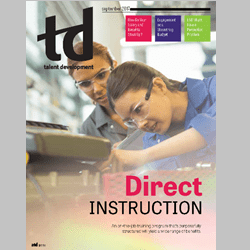TD Magazine Article
Engagement Adjustment
Low scores on the Federal Employee Viewpoint Survey prompted OSHA to prioritize making improvements.
Fri Sep 01 2017

Developing and sustaining an engaged, innovative, and productive workforce is a high priority for the federal government. The U.S. Office of Personnel Management defines employee engagement as "an employee's sense of purpose that is evident in their display of dedication, persistence, and effort in their work or overall attachment to their organization and its mission." The annual Federal Employee Viewpoint Survey contains questions that capture employees' perceptions of workplace conditions that contribute to employee engagement, as well as perceptions on questions about practices, policies, behaviors, and attitudes that support these workplace conditions.
In 2011, the U.S. Department of Labor (DOL) ranked 24th out of 33 agencies, placing it in the bottom third; and the Occupational Safety and Health Administration (OSHA) ranked 141st out of 240 sub-agencies, placing it in the bottom half. As such, there was clearly a need for improvement in terms of employee engagement and the workplace culture. As the third largest among the 23 sub-agencies within the DOL, OSHA's ability to demonstrate considerable improvement has a major impact on the DOL's overall engagement results.
And during the past five years, the DOL and OSHA have made substantial improvement in the area of employee engagement.
Putting an improvement plan in place
Through analysis of the survey results, OSHA identified key drivers for engagement to include work-life balance, performance feedback and rating, training and development, and collaborative management. An executive steering committee was assembled to improve the work environment; in turn, the committee established working groups focused on the key engagement drivers. The agency also developed annual action plans and implemented a series of programs and initiatives that provide employees at all levels with new training and developmental opportunities; develop managers, from frontline supervisors to senior leaders, with the skills to lead effective teams, motivate employees, and achieve agency goals; and improve the performance appraisal process by clarifying performance expectations and ensuring that employees are recognized for a job well done.
Work-life balance
To improve work-life balance, DOL implemented formalized telework and alternative work schedule programs. However, some managers were not administering these programs in the most effective manner. Training played a critical role in ensuring that managers were fully knowledgeable regarding all aspects of these programs and were properly administering the programs to the fullest potential application for employees.
Performance feedback
To improve the employee perception of performance feedback and the ratings process, OSHA developed the Employee Guide to the OSHA Performance Management System, which was sent to all employees. The work group developed manager training courses, which explained the role of both the employee and the supervisor in the process, and the agency developed manager tools that include tips to minimize negative reactions, guidance on performance language, and a checklist for an effective review discussion.
Collaborative management
To foster collaborative management, OSHA took several steps to teach managers the skills needed to lead effective teams and motivate employees. It drafted a new training directive for managers and developed agency-specific training for managers based on precise competencies needed for headquarters versus field locations. For staff, OSHA revised its initial training program for compliance personnel and developed a mandatory three-year training program for whistle-blower investigators.
In 2016, OSHA participated in a pilot program coordinated through the Performance Improvement Council, a government-wide body that supports cross-agency collaboration and the exchange of knowledge to advance and expand the practice of performance management and improvement. The Modern Government Management Traits (MGMT) initiative was inspired and modeled from Google's Project Oxygen, which was designed to identify the traits that successful managers demonstrate. The traits identified and used in MGMT included behaviors such as coaching, empowering, having an interest in direct reports' success, being a good communicator, performing technical skills, and demonstrating clear vision and strategy.
MGMT offered a simple way for managers to enhance their role in employee engagement by adopting the management behaviors that Google managers have used. MGMT was structured as a 16-week program with a minimal amount of time investment needed to obtain results. For each of the eight traits, managers participated in a 30-minute "trait talk" with staff, and then chose actions they committed to practicing over the next two weeks. This process was repeated every two weeks until all eight traits had been discussed, practiced, and implemented into daily management routines.
The results were consistently positive across all test groups. Employees appreciated the candid and open discussions and follow-up. They especially liked the managers holding regular one-on-ones, asking questions rather than dictating answers, and providing constructive feedback that balanced the negative and positive.
Training and development
The agency has long offered internal LMS-based online training, which includes a variety of courses ranging from software to information security. To make this training more widely accessible, one group reviewed numerous courses and published a guide with ratings and user reviews to help employees know which courses might be most helpful.
For the mandatory classroom training conducted for compliance officers, OSHA made a concerted effort to enhance its evaluation of training outcomes. In addition to measuring Levels 1 and 2 (reaction and learning), OSHA implemented a mechanism for obtaining Level 3 feedback to measure changes in behavior based on the training. That has enabled the agency to make important adjustments to curriculum and instructional design, including an increase in the percentage of hands-on and group exercises.
In the area of employee development, OSHA used multiple approaches for various levels of employees. The agency conducted scenario-based assessment centers for mid- to upper-level personnel to cultivate future high-potential employees. For top-level managers, the agency created the Executive Leadership Development Program for managers who could subsequently be considered for senior executive positions as vacancies occurred. Those efforts have proved fruitful given that multiple participants of the assessment center program and the Executive Leadership Development Program have been selected for senior executive positions.
But the agency also created a development program targeting entry- to midlevel personnel. The OSHA Administrative Development Program was launched as a 10-month career development program designed for administrative support employees seeking professional career advancement opportunities. The program is designed to develop participants' competencies in areas such as oral and written communications, interpersonal skills, financial management, customer service, and problem solving. The learning experiences include formal classroom training, online training, job shadowing, detail assignments, independent readings, cohort group meetings, and task force assignments.
Throughout the program, participants are assigned mentors who work with them to successfully navigate their way through each step of the program and discuss aspects of career development within the agency and beyond. Graduates receive a certification of achievement when they successfully complete all aspects of the program based on an evaluation of their work products and an exit interview.
Full- and part-time rotational assignments with another team, office, or DOL agency are additional development opportunities. Benefits for participants include experiencing the challenge of learning something new; developing and enhancing skills, knowledge, and abilities in technical or managerial areas; and adding diverse work experience to their resumes. The benefit to DOL is that the experience will increase employees' job satisfaction and broaden their awareness of other agency functions and programs, and generally strengthen employee-manager relationships through supporting coalition building between agencies.
An individual development plan (IDP) can be a valuable performance enhancement and career development tool for employees, but employee feedback indicated there was room for improvement in the process.
OSHA's approach was to train both managers and employees on the process to make it easier to understand and more transparent. The agency developed a guidebook and webinar that explained the roles and responsibilities of employees and supervisors in completing IDPs and outline a step-by-step process for preparing them. The guide helps employees and their supervisors analyze career goals and objectives, analyze the organization's needs for individual development planning, and prepare for the employee-supervisor IDP discussion. Employees benefit from focusing on their career development because doing so helps them to enhance their knowledge, skills, and job experiences. And improved competencies help them prepare for future opportunities and achieve personal and career goals both internally and externally to DOL.
In some cases, the survey results seemed to suggest a lack of awareness regarding available programs and opportunities for training and development. So OSHA created the Employee Engagement Intranet to improve communication, promote transparency, and make it easier for employees to find resources for training and development. The site displays survey results and agency action plans, and acts as a portal to a wide range of training and development materials, programs, and courses. These include TED Talks, massive open online courses such as Coursera and edX, and webinars offered free of charge.
Outcomes
OSHA has clearly invested time, energy, and resources into improving its level of employee engagement, with training and development being an essential component. The fruits of this labor are beginning to show. From a qualitative standpoint, the development efforts are paying dividends through continued participation in developmental programs, including filling multiple senior executive positions among Executive Leadership Development Program participants.
The improvement from a quantitative standpoint has been dramatic. Based on the 2016 Federal Employee Viewpoint Survey results, OSHA saw its positive scores increase on 77 of 78 survey questions, with an average overall increase of 3.9 percent per question. The agency averaged 3.8 percent higher per question than government-wide results, and there were 19 questions in which OSHA increased by 5 percent or higher.
There are several indices by which the survey data are analyzed, including employee engagement, global satisfaction, leadership, training, innovation, diversity, and performance appraisal. Including sub-categories, there are a total of 20 different measures. OSHA saw an increase in all 20 survey index measures, and also scored higher than government-wide results in all the index measures. Both DOL and OSHA show solid improvement in the government-wide rankings during a five-year period. By 2016, DOL improved from 24th to sixth place, and OSHA climbed from 141st among sub-agencies to 106th.
OSHA still has some work to do in the area of employee engagement, but the progress the agency has made in recent years gives a clear indication it is heading in the right direction.
Continual Improvement
Opportunities for employees to receive training and development are essential drivers of employee engagement. For other drivers such as work-life balance, performance feedback, and collaborative management, training both managers and employees in the fundamental use and application of these areas is the key to effectiveness.
A challenging fiscal environment does not have to be a barrier to providing training and development opportunities. Despite the constraints of federal budget cuts and even sequestration, the Occupational Safety and Health Administration (OSHA) found innovative ways to provide opportunities for its employees. Effective two-way communication ensures that training and development is a successful driver of employee engagement. Focus groups provided invaluable feedback related to areas for improvement in how the agency addressed training and development. Ensuring that employees understand the process for creating an individual development plan, are mindful of agency resources, and are aware of available training and development opportunities has played an important role in the improvement.
Dorothy Dougherty was the deputy assistant secretary for OSHA during much of the time when these changes occurred. Recently retired, she reflects on the progress the agency made while she was the ranking career executive. “Since 2012, we’ve done a better job of listening to employee input and acted to identify and address our agency’s employee engagement challenges. The work groups have been central to our continual improvement. These efforts and outcomes will have a certain impact on OSHA’s mission and culture for years going forward.”

